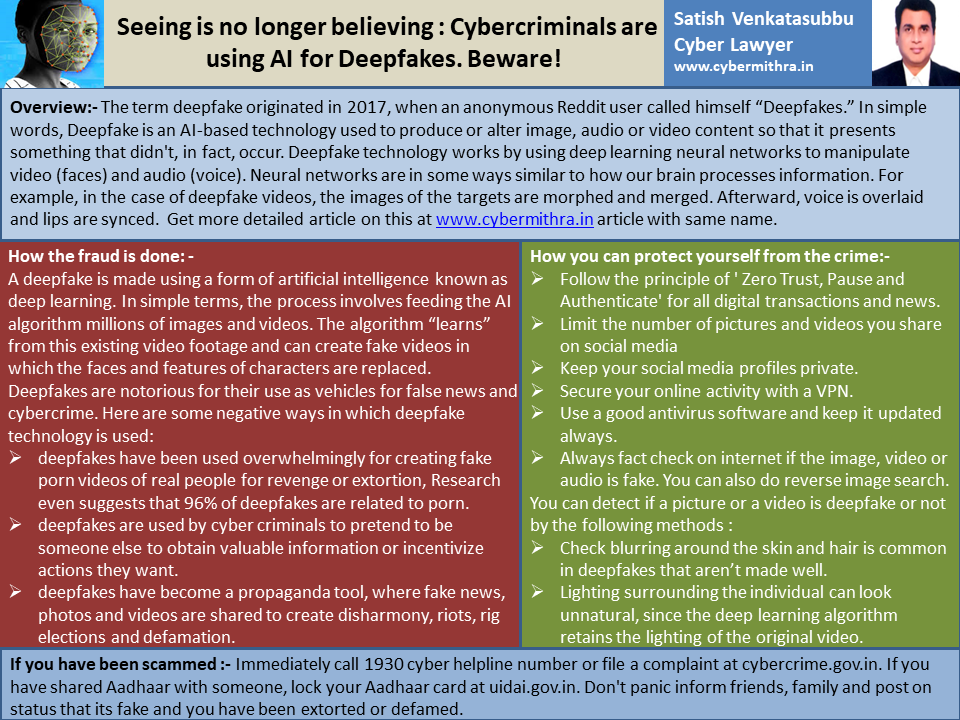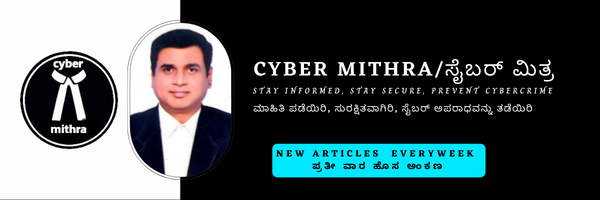“Seeing is no longer believing” : Cybercriminals are using AI for creating Deepfakes. Beware!
Deepfake cybercrimes are in the news for quite sometime. In continuation of how cybercriminals are using Artificial Intelligence(AI) tools for cybercrimes, last week I spoke about how ChatGPT was used for cybercrimes and this week I am going to talk about how cybercriminals are using deep fakes done with the help of AI tools for cybercrimes.
The term deepfake originated in 2017, when an anonymous Reddit user called himself “Deepfakes.” In simple words, Deepfake is an AI-based technology used to produce or alter image, audio or video content so that it presents something that didn’t, in fact, occur. Deepfake technology works by using deep learning neural networks to manipulate video (faces) and audio (voice). Neural networks are in some ways similar to how our brain processes information. For example, in the case of deepfake videos, the images of the targets are morphed and merged. Afterward, voice is overlaid and lips are synced.
Cyber criminals use facial mapping technologies to create an accurate facial symmetry data set. They use AI to swap the face of a person on to the face of another person. Apart from this, voice matching technology is used to accurately copy the user’s voice. It is then used to generate fake news and commit financial fraud among other wrongdoings.
Some of the major deep fakes which have caused a strom in recent times include:
- Deepfake video of President Zelenskyy telling Ukrainians to ‘lay down arms’ on national television during war last year caused huge confusion.
- Deepfake Videos Of BJP’s Manoj Tiwari Circulated During Delhi Polls.
- Deepfake photo of Indian wrestlers smiling after arrest caused outrage.
- In China, Con artist dupes man out of Rs 5 crores, uses deep fake AI to pose as friend, in urgent need of money.
Various governments, organisations like UN and experts are warning about the risks posed by deepfakes, like:
- UN Warns of AI-Generated Deepfakes Fueling Hate and Misinformation Online
- Weed out ‘deep fakes’, Ministry of Electronics and Information Technology(MeitY) tells social media platforms
- Microsoft chief says deep fakes are biggest AI concern
There are many AI apps like Zao, deepfakesweb, deepfacelab, Wombo etc which are making the high end AI technology available to cybercriminals to create sophisticated deepfakes.
How cybercriminals are using AI for creating deepfakes :-
A deepfake is made using a form of artificial intelligence known as deep learning. In simple terms, the process involves feeding the AI algorithm millions of images and videos. The algorithm “learns” from this existing video footage and can create fake videos in which the faces and features of characters are replaced.
Deepfakes are notorious for their use as vehicles for false news and cybercrime. Here are some negative ways in which deepfake technology is used:
- deepfakes have been used overwhelmingly for creating fake porn videos of real people for revenge or extortion, Research even suggests that 96% of deepfakes are related to porn.
- deepfakes are used by cyber criminals to pretend to be someone else to obtain valuable information or incentivize actions they want.
- deepfakes have become a propaganda tool, where fake news, photos and videos are shared to create dishormony, riots,rig elections and defamation.
How to prevent or detect deepfake crimes :-
- Always follow the principle of ‘ Zero Trust, Pause and Authenticate’ for all digital transactions and news.
- Limit the number of pictures and videos you share on social media
- Keep your social media profiles private.
- Secure your online activity with a VPN and firewall software.
- Use a good antivirus software and keep it updated always.
- Always fact check on internet if the image, video or audio is fake. You can also do reverse image search.
You can detect if a picture or a video is deepfake or not by the following methods :
- Check blurring around the skin and hair is common in deepfakes that aren’t made well.
- Lighting surrounding the individual can look unnatural, since the deep learning algorithm retains the lighting of the original video.
- mismatch between the audio and video or the lip sync is not proper is another sign to look out for
If you have been scammed :-
Immediately call 1930 cyber helpline number or file a complaint at cybercrime.gov.in. Call the concerned bank and lodge a complaint to freeze the funds. If you have shared Aadhaar with someone, lock your Aadhaar card at uidai.gov.in. Change user ids and passwords/pins of exposed banking accounts. Don’t panic inform friends, family and post on your social media status that its fake and you have been extorted or defamed.
Remedies available to victim legally(India) :-
- At present, India does not have any law specifically for deep fake cybercrime, but various other laws can be combined to deal with it.
- One can register a criminal case in cyber police station under :
- section 419 (punishment for cheating by impersonation) ,section 420 (cheating and dishonestly inducing delivery of property),section 463/464/465 (make a false document or false electronic record , forgery), and 499/500 (Defamation) of Indian Penal Code(IPC).
- Section 66D (punishment for fraud by impersonation using computer), Section 66E (violation of privacy), and Section 67A (Punishment for publishing or transmitting of material containing sexually explicit act, etc) under Information Technology Act(IT) Act 2000/08.

If you find this useful, please like it and share, also if you have any questions or topics you want me to cover please add them in the comments section. Also you can share one page poster covering the entire content with your friends and relatives in other social media.
Frequently Asked Questions :-
Is there any positive use of deep fake technology?
There are quite a lot of positive use cases of deepfake technology, like it can be helpful in dubbing movies to different languages easily, preparing interesting education materials etc
Can AI be used to detect deepfakes?
Yes, there is lot of work going on to use AI to detect if a image or video or audio is a deepfake or not. In near future, we may have realtime AI deepfake detection software.
Who created first deepfake program
Deepfakes started with the Video Rewrite program, created in 1997 by Christoph Bregler, Michele Covell, and Malcolm Slaney. The program altered existing video footage to create new content of someone mouthing words they didn’t speak in the original version.


Hi there, after reading this remarkable paragraph i am too cheerful to
share my familiarity here with mates.
Also visit my blog; vpn special